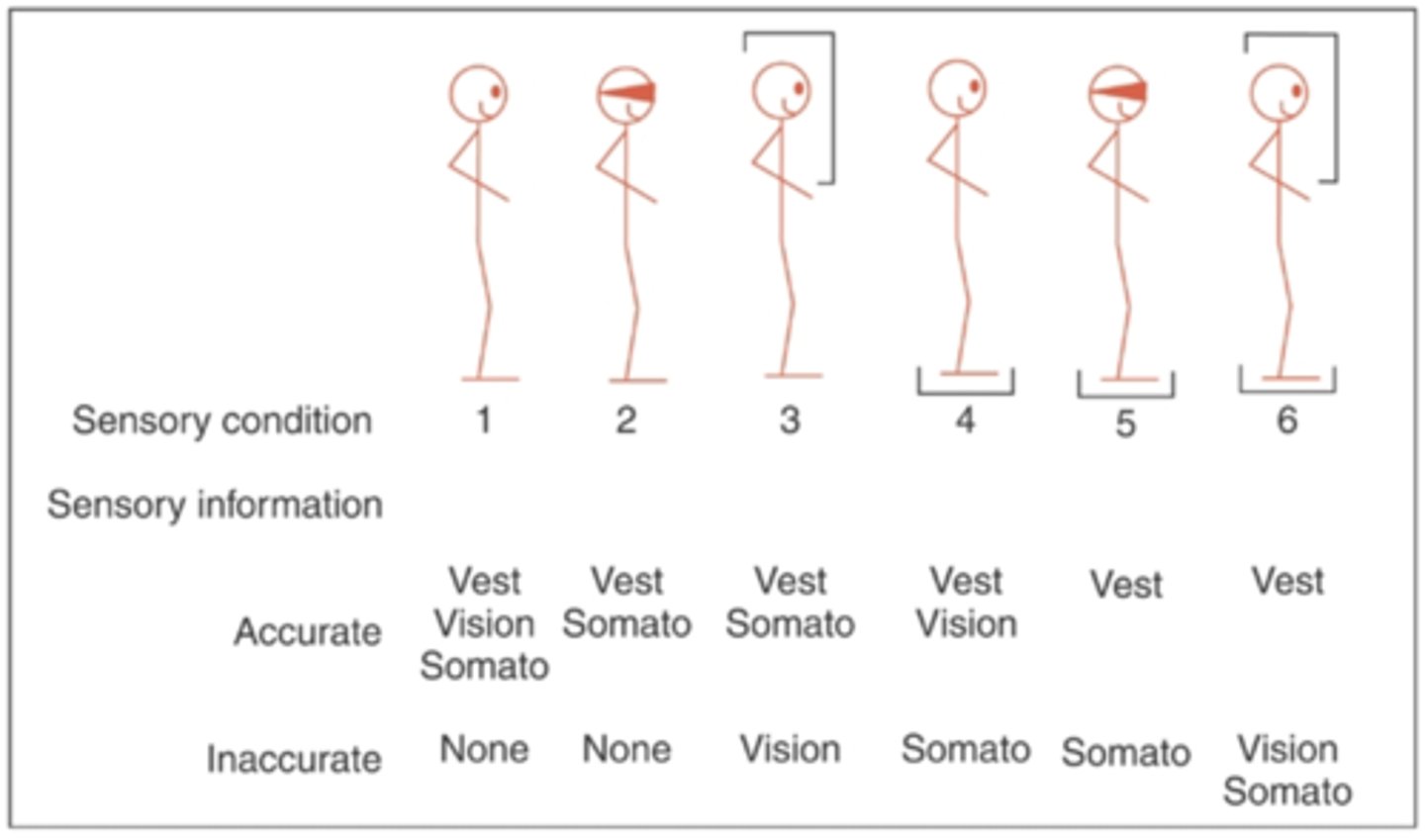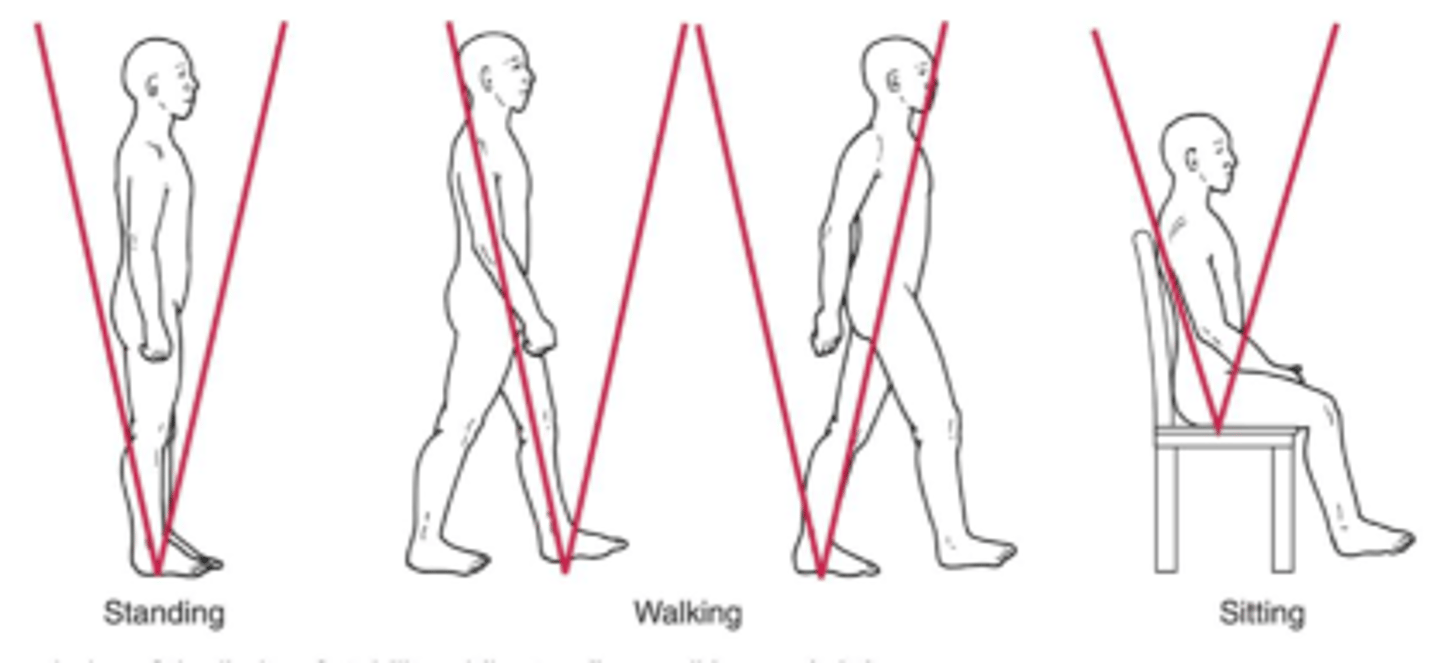Postural Control
1/68
There's no tags or description
Looks like no tags are added yet.
Name | Mastery | Learn | Test | Matching | Spaced |
|---|
No study sessions yet.
69 Terms
What is the universal definition of postural control and balance?
No universal definition
What are the neural mechanisms underlying control of posture and balance?
No agreement on all the neural mechanisms underlying control of posture and balance
What does postural control involve?
Controlling body's position in space for:
1. Postural orientation
2. Postural stability
What is postural orientation?
Ability to maintain appropriate relationship between body segments and between the body and environment for a task
What is postural stability?
Ability to control COM in relationship to the base of support
What is center of control (COM)?
Point at the center of the total body mass
- Typically around L1 vertebrae
What is center of pressure (COP)?
Center of distribution of total force applied to supporting surface
- GRF acting on body
- Good balance = COP aligned with COM
Relationship between COM and COP provides _ than either COP or COM alone.
better insight into stability
Postural requirements change for _ and _.
different tasks; different environments
Each individual solves postural demands with their _.
unique movement ability
What are the 3 aspects of a postural task?
1. Steady state: maintain a position
2. Reactive: have to react to maintain
3. Proactive: anticipatory-- assume a posture in a state of readiness
What are the 3 aspects of environment regarding postural control?
1. Support surface: thick foam vs pebbles vs grass
2. Cognitive load: environmental add-on, e.g. crowded spaces = greater load
3. Sensory context: from OUTSIDE, how much stimulation from the environment, e.g. movie theater
What are the 3 aspects of individual regarding postural control?
1. Motor: weakness, incoordination, motor planning problems
2. Sensory: how I interpret sensory info
3. Cognitive
What are the individual's systems for postural control?
1. Higher level planning: frontal cortex, motor cortex
2. Coordination: brainstem, spinal networks coordinating muscle response synergies
3. Force generation: motor neurons and muscles
4. Sensory/perceptual processes: visual, vestibular, somatosensory
What is the alignment of a quiet stance?
Minimizes the effects of gravity
What is muscle tone like during quiet stance?
Tone at rest
- Intrinsic stiffness of muscles: when non-contractile parts of muscle (fascia, tendons) get stiff
- Reticulospinal tract!
What is postural tone like during quiet stance?
Activation of antigravity muscles; vestibulospinal tract supports antigravity muscles
- Back extensors
- Abdominals
- Leg extensors
- Neck extensors
What 3 groups of lower extremity muscles are important antigravity muscles for postural tone?
1. Glutes
2. Gastroc-soleus
3. Quads
What are movement strategies during perturbed stance?
1. Feedback control
2. Feedforward (anticipatory) control: before it happens; not conscious
What are the 3 main strategies for antero-posterior stability?
Go from distal to proximal
1. Ankle strategy
2. Hip strategy
3. Stepping strategy
From distal to proximal, what are the antero-posterior stability strategies?
1. Ankle strategy = distal
2. Hip strategy = intermediate
3. Stepping strategy = proximal
What are alternate strategies that can be used, i.e. when there's a very large perturbation?
Recruited as a last resort:
1. Reach and grasp
2. Parachute response
3. Suspensory strategy
What is ankle strategy?
Postural sway control from the ankles and feet
How do the head and hips move during ankle strategy?
Head and hips move in the same direction, at the same time, as a unit
When is the ankle strategy used?
Response to small, slow, midline displacement; little midline shift
On what kinds of surfaces is ankle strategy used?
When surface is broad and stable enough to allow pressure against it
With ankle strategy, when a person sways forward, the _ muscles are activated.
posterior
1. Gastroc
2. Hamstrings
3. Paraspinals
With ankle strategy, when a person sways backwards, the _ muscles are activated.
anterior
1. Tibials
2. Quads
3. Abdominals
What is hip sway?
Postural sway control from the hip, pelvis, trunk
How do the head and hips move during hip strategy?
Head and hips travel in opposite directions (counterbalance)
When is the hip strategy used?
When movement is large, fast, nearing the limit of stability
On what kinds of surfaces is hip strategy used?
When the surface is too narrow or unstable to allow counter pressure
With hip strategy, when a person sways forward, the _ muscles are activated.
anterior
1. Abdominals
2. Quads
With hip strategy, when a person sways backwards, the _ muscles are activated.
posterior
1. Paraspinals
2. Hamstrings
What is stepping strategy?
An attempt to re-establish a new BOS with the active limb when the COG has exceeded the original BOS
What is suspensory strategy?
Lowering the COG toward the BOS
When is suspensory strategy used?
When a combination of mobility and stability is required
What is the reach and grasp strategy?
A complex strategy using multi-limb coordination
- Takes into account both: loss of balance and environmental factors (available/not available)
What are key research findings of the reach and grasp strategy?
1. Initiation and completion of this strategy takes half the time it takes to perform a similar voluntary movement
2. No pre-planning! Timing, direction, amplitude, speed are spontaneous (most likely pre-programmed)
What is medio-lateral stability predominated by?
Abduction-adduction at the hip
- Muscle patterns organized in a proximal-to-distal direction
What are multidirectional strategies?
No unique muscle activation pattern for each direction
- No clear synergy organization
- Complex CNS process modulated by continuous feedback signals that are context specific
Behavior is modified in response to what?
New tasks
- Ex: standing on firm surface (ankle strategy first) vs standing on narrow beam (hip strategy takes over)
What is a newer concept of the ankle>hip>step strategy?
Not everyone in this order
- Step strategy need not be the last in the sequencing
- Based on BOS and speed (new research)
What is a newer concept of the ankle>hip>step strategy being in this order with increasing speed?
Strategies need not change with speed
- Based on critical point (new research)- 1st increased muscle work at lower strategy until critical point
What determines the use of postural control strategies?
Individual factors
What is a clinical application of postural control strategies?
Train for ALL strategies, in all environments, for all postural demands
What is proactive balance control?
Anticipatory postural muscle activity seen before voluntary arm and leg movement
What are the phases of proactive balance control?
1. Preparatory phase
2. Compensatory phase
What is the preparatory phase of proactive balance control?
50ms before voluntary movement
- Compensate for destabilizing forces
What is the compensatory phase of proactive balance control?
Reactivation after voluntary movement
- Stabilize body with feedback
What sensory systems play an important role in postural control?
Postural control is not just ability to generate and apply forces to control body's position!
1. Somatosensory system
2. Vestibular system
3. Visual system
What is the sensory organization test (SOT)?
Way to assess how 3 sensory systems are working for balance
- Eyes open/closed on firm vs foam pad surface with/without surround
- Pt uses shoes

How do cognitive systems affect postural control?
Attentional demands of postural control; attentional demands vary based on:
1. Age
2. Postural task
3. Individual's balance ability
*Ex: spatial vs non-spatial memory tasks during balance activities
If a person over 50 years old can't walk and talk with you, what should you assess first?
Balance
What are clinical applications of control strategies?
1. Pre-programmed synergy mechanism
2. Continuous feedback system
What are clinical applications of strategy/surface activations?
Not to limit activation to 1 strategy/surface
1. Multiple strategies depending on T/E factors
2. Transference is possible
What happens if the ankle/hip/stepping strategy is too slow?
Fall
What are slow strategies/falls dependent on?
1. The particular perturbation
2. Limitation of the individual
3. Conditions of the environment
What are types of dynamic posturography?
1. Limits of Stability
2. Sensory Organization Test (SOT)
What is Limits of Stability?
The furthest distance in any direction a person can lean away from midline (vertical) without altering the original BOS (i.e. without stepping, reaching, falling)

What is the SOT for?
To ID problems with postural control in 6 different conditions
- Measurement of sway energy under various visual and support conditions
For SOT, what are the different conditions like?
Progressively complicated, a combination of:
1. Eyes open/closed
2. Sway referencing, i.e. foot plate moving/not moving
3. Surround referencing, i.e. surround moving/not moving
List out the 6 conditions for SOT.
1. Vision present, surround fixed, surface fixed
2. Vision absent, surround fixed, surface fixed
3. Vision present, surround moving, surface fixed
4. Vision present, surround fixed, surface moving
5. Vision absent, surround fixed, surface moving
6. Vision present, surround moving, surface moving
With stable vision (EO) and stable surface, what is the expected system response?
1. Advantaged/active = all/somatosensation
2. Disadvantaged = none
With absent vision (EC) and stable surface, what is the expected system response?
1. Advantaged/active = somatosensation
2. Disadvantaged = vision
With unstable vision and stable surface, what is the expected system response?
1. Advantaged/active = somatosensation
2. Disadvantaged = vision
With stable vision (EO) and unstable surface, what is the expected system response?
1. Advantaged/active = visual, vestibular
2. Disadvantaged = somatosensation
With absent vision (EC) and unstable surface, what is the expected system response?
1. Advantaged/active = vestibular
2. Disadvantaged = somatosensation, vision
With unstable vision and unstable surface, what is the expected system response?
1. Advantaged/active = vestibular
2. Disadvantaged = somatosensation, vision